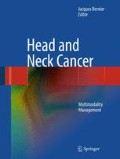Abstract
Functional imaging has found widespread use within the last years due to the increasing availability of PET and PET/CT systems worldwide. The most frequently used tracer for PET examinations is F-18-deoxyglucose, which is transported like glucose into the cells and phosphorylated, but then trapped. Dynamic PET examinations provide detailed information about the kinetics of the tracer and facilitate the detection and delineation of lesions by parametric imaging techniques. However, even static images 1 h after tracer injection are helpful to assess malignant lesions. Tumor diagnostics is improved by the combination of PET and CT or MRI by the use of image fusion techniques. Radiotherapy planning is improved by the inclusion of functional images and the better delineation of a tumor. Other tracers like F-18-FLT provide information about the proliferation, and tracers like F-18-misonidazole can be used to assess hypoxia in tumors. Especially, hypoxia imaging is helpful for the radiotherapy of patients.
Access this chapter
Tax calculation will be finalised at checkout
Purchases are for personal use only
References
Leslie A, Fyfe E, Guest P, Goddard P, Kabala JE. Staging of squamous cell carcinoma of the oral cavity and oropharynx: a comparison of MRI and CT in T- and N-staging. J Comput Assist Tomogr. 1999;23:43–9.
Strauss LG, Conti PS. The applications of PET in clinical oncology. J Nucl Med. 1991;32:623–48. discussion 649–50.
Minn H, Joensuu H, Ahonen A, Klemi P. Fluorodeoxyglucose imaging: a method to assess the proliferative activity of human cancer in vivo comparison with DNA flow cytometry in head and neck tumors. Cancer. 1988;61:1776–81.
Haberkorn U, Strauss LG, Reisser C, et al. Glucose uptake, perfusion, and cell proliferation in head and neck tumors: relation of positron emission tomography to flow cytometry. J Nucl Med. 1991;32:1548–55.
Gambhir SS, Czernin J, Schwimmer J, Silverman DH, Coleman RE, Phelps ME. A tabulated summary of the FDG PET literature. J Nucl Med. 2001;42:1S–93S.
Strauss L, Bostel F, Clorius JH, Raptou E, Wellman H, Georgi P. Single-photon emission computed tomography (SPECT) for assessment of hepatic lesions. J Nucl Med. 1982;23:1059–65.
Branstetter BFt, Blodgett TM, Zimmer LA, et al. Head and neck malignancy: is PET/CT more accurate than PET or CT alone? Radiology. 2005;235:580–6.
Goerres GW, von Schulthess GK, Steinert HC. Why most PET of lung and head-and-neck cancer will be PET/CT. J Nucl Med. 2004;45 Suppl 1:66S–71S.
Ng SH, Joseph CT, Chan SC, et al. Clinical usefulness of 18F-FDG PET in nasopharyngeal carcinoma patients with questionable MRI findings for recurrence. J Nucl Med. 2004;45:1669–76.
Shields AF, Lim K, Grierson J, Link J, Krohn KA. Utilization of labeled thymidine in DNA synthesis: studies for PET. J Nucl Med. 1990;31:337–42.
Troost EG, Vogel WV, Merkx MA, et al. 18F-FLT PET does not discriminate between reactive and metastatic lymph nodes in primary head and neck cancer patients. J Nucl Med. 2007;48:726–35.
Beer AJ, Haubner R, Wolf I, et al. PET-based human dosimetry of 18F-galacto-RGD, a new radiotracer for imaging alpha v beta3 expression. J Nucl Med. 2006;47:763–9.
De Boer JR, Pruim J, Burlage F, et al. Therapy evaluation of laryngeal carcinomas by tyrosine-pet. Head Neck. 2003;25:634–44.
Halfpenny W, Hain SF, Biassoni L, Maisey MN, Sherman JA, McGurk M. FDG-PET. A possible prognostic factor in head and neck cancer. Br J Cancer. 2002;86:512–6.
Haberkorn U, Strauss LG, Dimitrakopoulou A, et al. Fluorodeoxyglucose imaging of advanced head and neck cancer after chemotherapy. J Nucl Med. 1993;34:12–7.
Harada H, Kizaka-Kondoh S, Li G, et al. Significance of HIF-1-active cells in angiogenesis and radioresistance. Oncogene. 2007;26:7508–16.
Harada H, Itasaka S, Zhu Y, et al. Treatment regimen determines whether an HIF-1 inhibitor enhances or inhibits the effect of radiation therapy. Br J Cancer. 2009;100:747–57.
Strauss LG, Klippel S, Koczan D, et al. Correlation of hypoxia associated genes with FDG uptake and kinetics [abstract]. J Nucl Med. 2008;49(Suppl):346P.
Strauss LG, Dimitrakopoulou-Strauss A, Koczan D, et al. 18F-FDG kinetics and gene expression in giant cell tumors. J Nucl Med. 2004;45:1528–35.
Mathias CJ, Welch MJ, Kilbourn MR, et al. Radiolabeled hypoxic cell sensitizers: tracers for assessment of ischemia. Life Sci. 1987;41:199–206.
Koh WJ, Bergman KS, Rasey JS, et al. Evaluation of oxygenation status during fractionated radiotherapy in human nonsmall cell lung cancers using [F-18]fluoromisonidazole positron emission tomography. Int J Radiat Oncol Biol Phys. 1995;33:391–8.
Rajendran JG, Schwartz DL, O’Sullivan J, et al. Tumor hypoxia imaging with [F-18] fluoromisonidazole positron emission tomography in head and neck cancer. Clin Cancer Res. 2006;12:5435–41.
Postema EJ, McEwan AJ, Riauka TA, et al. Initial results of hypoxia imaging using 1-alpha-D: -(5-deoxy-5-[(18)F]-fluoroarabinofuranosyl)-2-nitroimidazole ( (18)F-FAZA). Eur J Nucl Med Mol Imaging. 2009;36(10):1565–73.
Holland JP, Lewis JS, Dehdashti F. Assessing tumor hypoxia by positron emission tomography with Cu-ATSM. Q J Nucl Med Mol Imaging. 2009;53:193–200.
Dence CS, Ponde DE, Welch MJ, Lewis JS. Autoradiographic and small-animal PET comparisons between (18)F-FMISO, (18)F-FDG, (18)F-FLT and the hypoxic selective (64)Cu-ATSM in a rodent model of cancer. Nucl Med Biol. 2008;35:713–20.
Author information
Authors and Affiliations
Corresponding author
Editor information
Editors and Affiliations
Rights and permissions
Copyright information
© 2011 Springer Science+Business Media, LLC
About this chapter
Cite this chapter
Strauss, L.G., Dimitrakopoulou-Strauss, A. (2011). Functional Imaging. In: Bernier, J. (eds) Head and Neck Cancer. Springer, New York, NY. https://doi.org/10.1007/978-1-4419-9464-6_15
Download citation
DOI: https://doi.org/10.1007/978-1-4419-9464-6_15
Published:
Publisher Name: Springer, New York, NY
Print ISBN: 978-1-4419-9463-9
Online ISBN: 978-1-4419-9464-6
eBook Packages: MedicineMedicine (R0)

